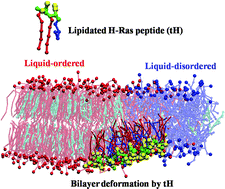Deformation of a two-domain lipid bilayer due to asymmetric insertion of lipid-modified Ras peptides†
Abstract
Ras proteins are attached to the inner leaflet of the plasma membrane via a lipid-modified anchor. Membrane-bound Ras proteins laterally segregate into nanoscale signaling platforms called nanoclusters. It has been shown that the membrane domain preference of Ras nanoclusters varies with the nature of lipidation but their effect on the membrane has not been well understood. To investigate the effect of Ras insertion on the membrane structure, we carried out numerous coarse-grained molecular dynamics (CGMD) simulations on a two-domain DPPC/DLiPC/cholesterol lipid bilayer in which different numbers and types of H-Ras peptides were attached on one side. We have shown previously that this lipid mixture forms co-existing liquid-ordered/liquid-disordered (Lo/Ld) domains and that different H-Ras peptides form clusters that variously accumulate in the Lo/Ld regions or the boundary between them. Here we show that asymmetric insertion of each of these peptides induces a vertical relative displacement of the domains and deforms the bilayer, with the domain boundary serving as the center of deformation. The extent of deformation, however, varies with the type and number of lipid modifications which determine the degree to which the stress caused by asymmetric peptide insertion is relieved by inter-leaflet cholesterol transfer and lipid tilt. In addition, we have characterized the mechanism of bilayer deformation based on the collective effect of the Ras peptides on the inter-leaflet surface area, pressure profile and line tension differences. This allowed us to elucidate how Ras lipid modification affects membrane geometry and how a two-domain bilayer adjusts its shape through boundary deformation. The result contributes to a better understanding of Ras signaling platforms and highlights some of the mechanisms by which a multi-domain membrane responds to external perturbation.


 Please wait while we load your content...
Please wait while we load your content...